The Rocketeer (film)
6.6 /10 1 Votes
61% Rotten Tomatoes Duration Language English | 6.4/10 IMDb 3/4 Roger Ebert Genre Action, Adventure, Family Initial DVD release August 17, 1999 Country United States | |||||||||||||||||||||||||||||||||
 | ||||||||||||||||||||||||||||||||||
Release date June 21, 1991 (1991-06-21) Based on The Rocketeer byDave Stevens Writer Dave Stevens (graphic novel "The Rocketeer"), Danny Bilson (story), Paul De Meo (story), William Dear (story), Danny Bilson (screenplay), Paul De Meo (screenplay) Cast (Cliff Secord), (Jenny Blake), (A. 'Peevy' Peabody), (Neville Sinclair), (Eddie Valentine), (Howard Hughes) Similar movies Joe Johnston directed The Rocketeer and Captain America: The First Avenger Tagline Three years before the United States declares war, Cliff Secord leads America's first battle against the Nazis. | ||||||||||||||||||||||||||||||||||
The rocketeer 1991 trailer
Cliff Secord (Bill Campbell) is a cocky stunt pilot in love with a beautiful actress, Jenny Blake (Jennifer Connelly). When he discovers a jet pack hidden in a biplane, Cliff straps on the rocket, dons a flashy helmet and becomes the high-flying hero known as The Rocketeer. But when Nazis want to use the rocket as a weapon, Cliff must use his alter ego to both protect Jenny from an evil actor (Timothy Dalton) and save the day in this period adventure based on the comic books by Dave Stevens.
Contents
- The rocketeer 1991 trailer
- Plot
- Cast
- Development
- Casting
- Filming
- Design
- Visual effects
- Soundtrack
- Marketing
- Home media
- Box office
- Critical response
- Accolades
- Similar Movies
- Sequels
- References
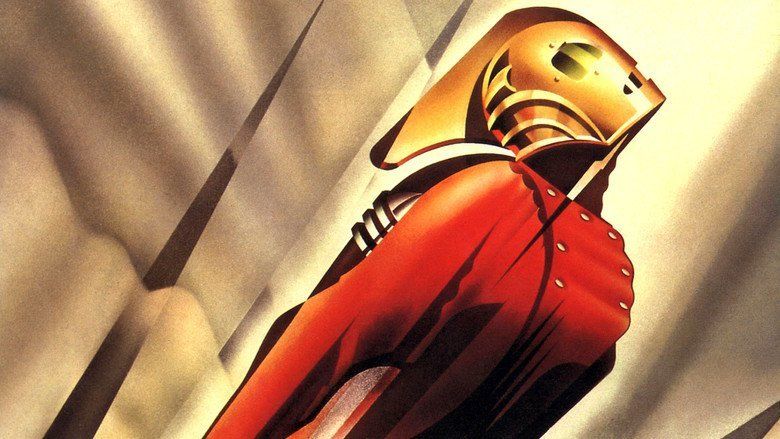
The Rocketeer is a 1991 American period superhero film produced by Walt Disney Pictures and based on the character of the same name created by comic book writer/artist Dave Stevens. Directed by Joe Johnston, the film stars Billy Campbell, Jennifer Connelly, Alan Arkin, Timothy Dalton, Paul Sorvino and Tiny Ron Taylor. Set in 1938 Los Angeles, California, The Rocketeer tells the story of stunt pilot Cliff Secord who discovers a jet pack that enables him to fly. His heroic deeds attract the attention of Howard Hughes and the FBI, as well as sadistic Nazi operatives.

Development for The Rocketeer started as far back as 1983, when Stevens sold the film rights. Steve Miner and William Dear considered directing The Rocketeer before Johnston signed on. Screenwriters Danny Bilson and Paul De Meo had creative differences with Disney, which caused the film to languish in development hell. The studio also intended to change the trademark helmet design; Disney CEO Michael Eisner wanted a straight NASA-type helmet, but Johnston convinced the studio otherwise. Johnston also had to convince Disney to let him cast unknown actor Billy Campbell in the lead role. Filming for The Rocketeer lasted from September 19, 1990 to January 22, 1991. The visual effects sequences were created and designed by Industrial Light & Magic.
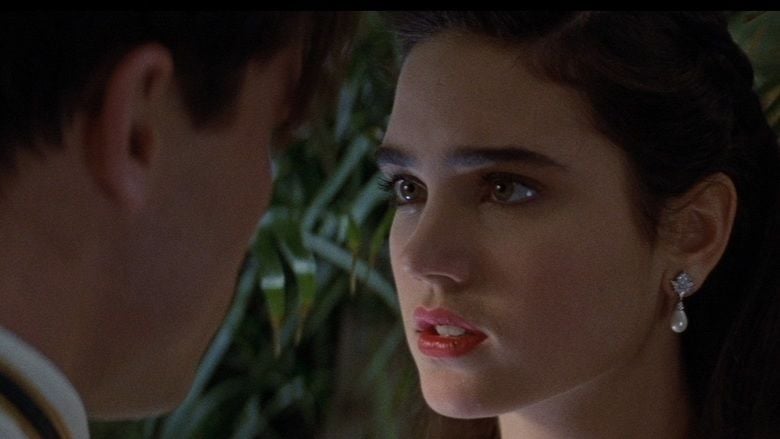
The film was released on June 21, 1991 and received generally favorable reviews from critics, although plans for Rocketeer sequels were abandoned after the film failed to perform at the box office. As of 2012, new efforts have been made for a remake.
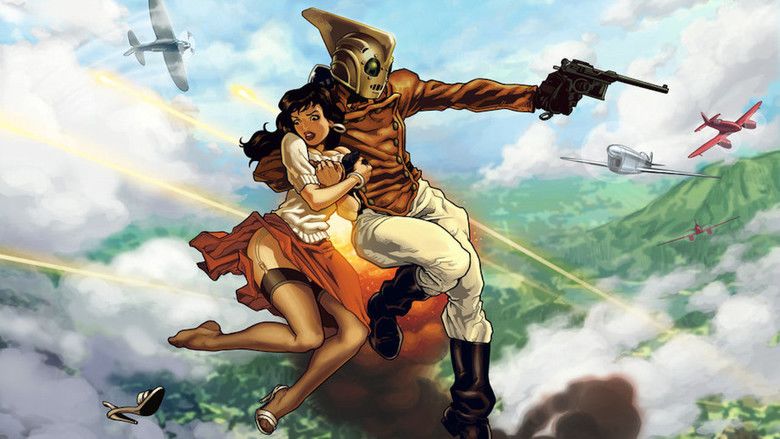
Straight from the pages of a pulp comic from a past era, the Rocketeer recreates 1930's Hollywood, complete with gangsters, Nazi spies, and the growth of the Age of Aviation. Young pilot Cliff Secord stumbles on a top secret rocket-pack and with the help of his mechanic/mentor, Peevy, he attempts to save his girl and stop the Nazis as The Rocketeer.
Plot
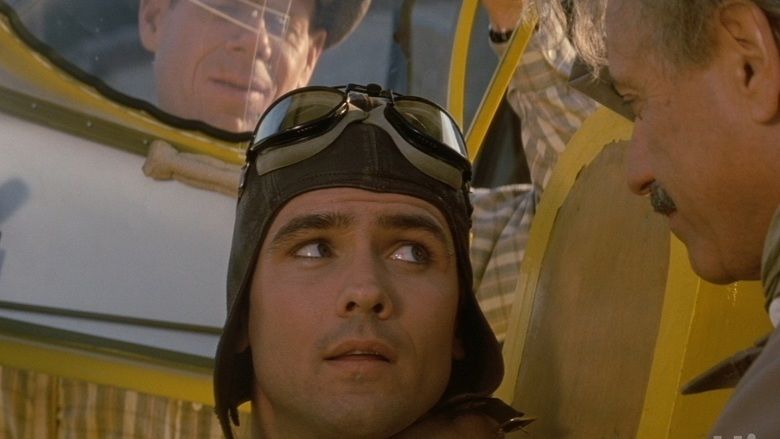
In 1938 Los Angeles, California, a rocket pack designed by Howard Hughes is stolen from his factory by two members of mobster Eddie Valentines gang, hotly pursued by FBI agents to an airfield, where one is killed, but the injured driver is caught. Stunt pilot Cliff Secord and mechanic A. "Peevy" Peabody, whose Gee Bee racer was irreparably damaged by the mobsters, find the mysterious rocket inside a biplane of their employers hangar, where the getaway driver hid it. Cliff and Peevy test with the rocket for a little while, but Peevy cautions Cliff about the dangers involved. Meanwhile, Valentine argues with movie star Neville Sinclair, a Nazi secret agent, who had hired Valentines gang to obtain the rocket from Hughes. Sinclair sends his monstrous henchman, Lothar, to the hospital, where the injured getaway driver tells him that he hid the rocket at the airfield. Lothar then kills him. Sinclair negotiates a new deal and dispatches the mobsters to search for the missing device.
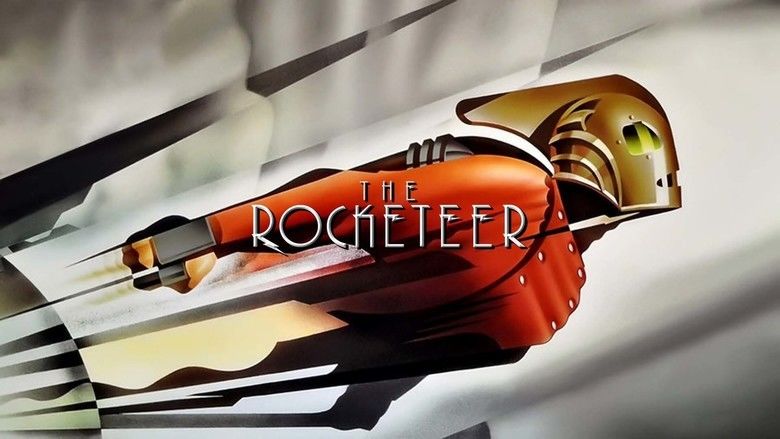
Cliff and his aspiring actress girlfriend, Jenny Blake, begin to have relationship issues after he visits her on a film set during a shoot, inadvertently causing an accident. Jenny is fired over Cliffs accident. However, Sinclair overhears Cliffs attempt to tell Jenny about the rocket pack. After Cliff leaves, Sinclair makes up to Jenny and invites her to dinner at the famed South Seas Club. Shortly afterward, at an airshow, Cliff uses the rocket (with Peevys newly designed face-hiding helmet) to heroically rescue his elderly friend Malcolm piloting a malfunctioned aircraft. Having been seen by the audience, "the Rocketeer" becomes a media sensation.
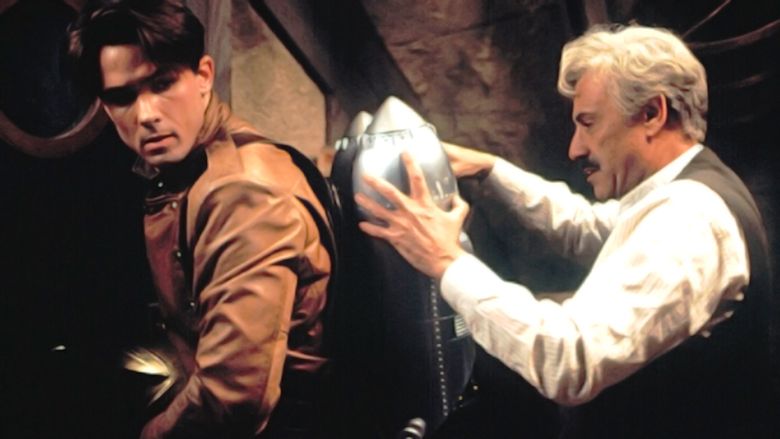
Sinclair dispatches Lothar to retrieve the rocket, who seizes detailed schematics drawn up by Peevy. The arrival of the FBI ends with Cliff and Peevy escaping with the rocket; Lothar also escapes. At the local diner, Cliff and Peevy, trapped by a team of mobsters, learn that Jenny had a date with Sinclair and of the latters involvement with the crime. The diner patrons overpower the mobsters, but a ricochet punctures the rocket packs fuel tank, which Peevy provisionally patches with Cliffs chewing gum. At the South Seas Club, Cliff is nearly trapped by Valentines gang, and, in the ensuing melee, Jenny is kidnapped by Sinclair.

At his villa, Sinclair tries to seduce Jenny, but she discovers that he is a spy and knocks him out. With Lothars aid, Sinclair recaptures her and leaves a message for Cliff to bring the rocket pack to the Griffith Observatory that night in exchange for Jennys life. Just before he is arrested by the FBI and taken to see Hughes, Cliff hides the rocket. Hughes reveals that the rocket was a prototype similar to one Nazi scientists were unsuccessfully developing to invade the United States . The FBI agents say they are tracking a Nazi spy in Hollywood, whom Cliff realizes is Sinclair. When Hughes demands the return of the rocket, Cliff explains that he needs it to rescue Jenny and Cliff escapes, but inadvertently leaves behind a clue to where he is going .
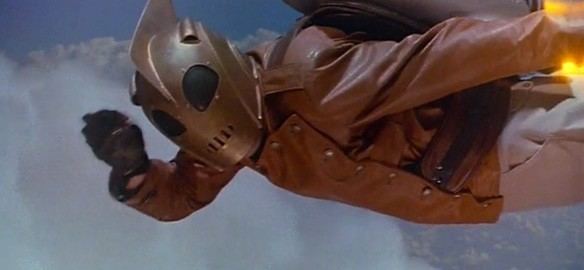
As the "Rocketeer", Cliff flies to the rendezvous where Sinclair, Lothar, and the Valentine gang are waiting. When Sinclair demands the rocket, Cliff divulges to the gang that the actor is a Nazi spy. Eddie, drawing the line at treason and more particularly working for Nazis, declares that he is "100% American" and turns his guns on Sinclair and Lothar. In response, speaking in German, Sinclair unexpectedly summons 60 heavily armed SA German commandos hidden nearby. The gangsters are held at gunpoint as a Nazi zeppelin, the Luxembourg appears overhead to evacuate Sinclair and his associates, who orders their prisoners shot. Suddenly, FBI agents announce their presence, having surrounded the area and both they and the gangsters find themselves joining forces to battle the Nazis. Sinclair and Lothar escape the shoot out with Jenny aboard the zeppelin.

Cliff uses the rocketpack to reach and board the zeppelin, but, during the ensuing showdown, Jenny accidentally sets the craft on fire with a flare gun. Sinclair takes the rocket to save himself, but Cliff pulls off the chewing gum patch. In the explosion, Sinclair dies, crashing into the last four giant letters of the "Hollywoodland" sign. Lothar is engulfed in flames as the zeppelin explodes, but Cliff and Jenny are rescued at the last instant by Hughes and Peevy in an autogyro.
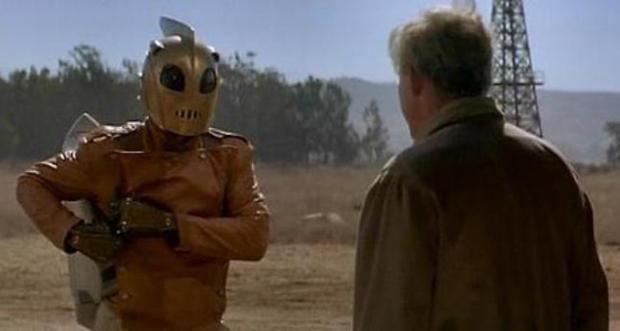
Hughes later presents Cliff with a brand-new Gee Bee racer. As Hughes leaves, Jenny presents Peevy with the rocket blueprints she found in Sinclairs villa and he decides that, with some modifications, he can build an even better one.
Cast
As appearing in The Rocketeer, (main roles and screen credits identified):
Development
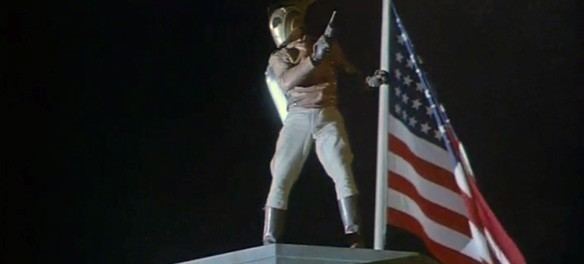
Comic book writer/artist Dave Stevens created the Rocketeer in 1982 and immediately viewed the character as an ideal protagonist for a film adaptation. Steve Miner purchased the film rights from Stevens in 1983 but he strayed too far from the original concept and the rights reverted to Stevens. In 1985, Stevens gave writers Danny Bilson and Paul De Meo a free option over The Rocketeer rights. Stevens liked that "their ideas for The Rocketeer were heartfelt and affectionate tributes to the 1930s serials with all the right dialogue and atmosphere. Most people would approach my character contemporarily, but Danny and Paul saw them as pre-war mugs."
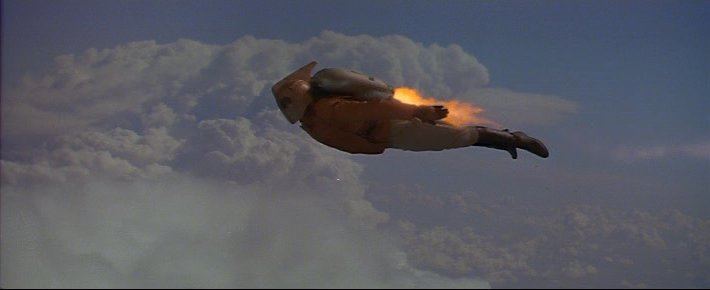
Stevens, Bilson and De Meo began to consider making The Rocketeer as a low-budget film, shot in black-and-white and funded by independent investors. Their plan was to make the film a complete homage to the Commando Cody serial films, and use a cast largely associated with character actors. However, that same year, the trio approached William Dear to direct/co-write The Rocketeer and they eventually dropped the low-budget idea. Bilson, De Meo and Dear kept the comic books basic plot intact but fleshed it out to include a Hollywood setting and a climactic battle against a Nazi zeppelin. They also tweaked Cliffs girlfriend to avoid comparisons to Bettie Page (Stevens’ original inspiration), changing her name from Betty to Jenny and her profession from nude model to Hollywood extra (a change also made to make the film more family friendly). Dear proceeded to transform the climax from a submarine into a zeppelin setpiece.

Stevens, Bilson, De Meo and Dear began to pitch The Rocketeer in 1986 to the major film studios but were turned down. "This was 1986, long before Batman or Dick Tracy or anything similar", Stevens explained. "In those days, no studio was interested at all in an expensive comic book movie. We got there about three years too early for our own good!" Walt Disney Studios eventually accepted The Rocketeer because they believed the film had toyetic potential and appeal for merchandising. The Rocketeer was set to be released through the studios Touchstone Pictures label; Stevens, Bilson, De Meo and Dear all signed a contract which would permit them to make a trilogy of Rocketeer movies. However, Disney studio chairman Jeffrey Katzenberg switched the film to a Walt Disney Pictures release. According to Stevens, "immediately, Betty and anything else adult went right out with the bathwater. They really tried to shoehorn it into a kiddie property so they could sell toys. All they really wanted at the end of the day, was the name".
Initially, Disney executives wanted to set the film in contemporary times, out of concern that a period piece might not appeal to a large audience. However, Bilson and DeMeo argued that the success of the Indiana Jones trilogy proved that ticketgoers would enjoy an adventure film set in the 1930s, and the studio finally agreed.
Bilson and DeMeo then submitted their seven-page film treatment to Disney, but the studio put their script through an endless series of revisions. Over five years, Disney fired and rehired Bilson and DeMeo three times. DeMeo explained that "Disney felt that they needed a different approach to the script, which meant bringing in someone else. But those scripts were thrown out and we were always brought back on." They found the studios constant tinkering with the screenplay to be a frustrating process as "executives would like previously excised dialogue three months later. Scenes that had been thrown out two years ago were put back in. What was the point?" DeMeo said. One of Bilson and De Meos significant revisions to the script over the years was to make Cliff and Jennys romance more believable and avoid cliche aspects that would stereotype Jenny as a damsel in distress. The numerous project delays forced Dear to drop out as director. Joe Johnston, a fan of the comic book, immediately offered his services as director when he found out Disney owned the film rights. Johnston was quickly hired and pre-production started in early-1990. After Bilson and De Meos third major rewrite, Disney finally greenlighted The Rocketeer.
The characterization of Neville Sinclair was inspired by movie star Errol Flynn, or rather by the image of Flynn that had been popularized by Charles Highams unauthorized and fabricated biography of the actor, in which he asserted that Flynn was, among other things, a Nazi spy. The films Neville Sinclair is, like Highams Flynn, a movie star known for his work in swashbuckler roles, and who is secretly a Nazi spy. Because Highams biography of Flynn was not refuted until the late 1980s, the image of Flynn as a closet Nazi remained current all through the arduous process of writing and re-writing the script. The other real-life characterization was of Howard Hughes.
Casting
Casting the lead role of Cliff Secord was a struggle for the filmmakers. Disney executive Jeffrey Katzenberg even had one of the studios then-staff writers, Karey Kirkpatrick, audition for the part. Kevin Costner and Matthew Modine were the first actors considered for the role. When they both proved to be unavailable, Dennis Quaid, Kurt Russell, Bill Paxton and Emilio Estevez auditioned for the part. Johnny Depp was Disneys favorite choice, while Paxton commented he came "really close" to getting the lead. Vincent DOnofrio turned down the role and the filmmakers were forced to continue their search.
The decision to cast Billy Campbell as Cliff Secord caused mixed emotions amongst Disney executives. Director Joe Johnston and creator Dave Stevens believed Campbell was perfect for the role, but Disney wanted an A-list actor. Johnston eventually convinced Disney otherwise. Campbell was not familiar with the comic book when he got the part but quickly read it, in addition to books on aviation. He also prepared by listening to 1940s period music. The actor had a fear of flying but overcame it with the help of the films aerial coordinator, Craig Hosking. To ensure his safety, Campbell was doubled for almost all of the flying sequences in conventional aircraft. Ultimately, a scale model devised by ILM puppeteer Tom St. Amand was used for all the rocket pack scenes.
For the female lead of Cliffs girlfriend Jenny, Sherilyn Fenn, Kelly Preston, Diane Lane and Elizabeth McGovern were considered before Jennifer Connelly was eventually cast. Campbell and Connellys working relationship eventually led to a romantic coupling, which Johnston found to be a technique for method acting that helped with their on-screen chemistry. For Secords sidekick, Peevy, Dave Stevens hoped that Lloyd Bridges would play the part, but Bridges turned it down and Alan Arkin was cast. The part of Neville Sinclair was offered to Jeremy Irons and Charles Dance before Timothy Dalton accepted the role. Lastly, the part of Eddie Valentine was written with Joe Pesci in mind, but he turned down the part, which went to Paul Sorvino.
Remaining cast members included Tiny Ron Taylor as Lothar, Terry OQuinn as Howard Hughes, Jon Polito as Otis Bigelow, Ed Lauter as Agent Fitch, Eddie Jones as Malcolm the Mechanic and Robert Miranda as Spanish Johnny. Rocketeer creator Dave Stevens has a cameo as the German test pilot who is killed when the Nazis version of a rocket backpack explodes during the takeoff sequence.
Filming
Principal photography for The Rocketeer lasted from September 19, 1990 to January 22, 1991. Filming at the Griffith Observatory took place in November 1990. The film ended up going 50 days over schedule due to weather and mechanical problems. Rocketeer creator Dave Stevens allied himself with director Joe Johnston and production manager Ian Bryce in an effort to be as heavily involved in the production process as possible and to try and secure as much artistic control as he could from Disney. Disney, in particular, was not enthusiastic with Stevens involvement. "I was on the set day and night", Stevens reflected, "from pre-production till post-production! And initially, I had to fight to prove that I was there for the benefit of the film, and not for my own ego."
The original production budget was set at $25 million, but rose to $40 million. This happened after Disney became impressed with the dailies; "they realized this was a bigger movie than they were anticipating", Johnston explained, "and they approved overages. It never got completely out of control." An abandoned World War II runway at the Santa Maria, California airport set the scene for the fictional Chaplin Air Field. Additional scenes were shot at Bakersfield. For the air circus scene, 700 Santa Maria extras and 25 vintage aircraft were employed. Aerial coordinator Craig Hosking remarked in an interview, "What makes The Rocketeer so unique was having several one-of-a-kind planes that hadn’t flown in years," including a 1916 Standard biplane and a Gee Bee Model Z racer. The sequence where Cliff rescues Malcolm was adapted shot-for-shot from Stevens comic book.
Design
Stevens gave the films production designer Jim Bissell and his two art directors, his entire reference library pertaining to the Rocketeer at that time period, including blueprints for hangars and bleachers, schematics for building the autogyro, photos and drawings of the Bulldog Cafe, the uniforms for the air circus staff, and contacts for locating the vintage aircraft that were to be used. Stevens remembers that they "literally just took the reference and built the sets". Disney originally intended to change the Rocketeers trademark helmet design completely. President Michael Eisner wanted a straight NASA-type helmet but director Johnston threatened to quit production on The Rocketeer. Disney relented, but only after creating a number of prototype designs that were ultimately rejected by the filmmakers. Stevens asked Johnston for one week to produce a good helmet design. He proceeded to work with a sculptor he knew, made a cast of the films main stunt mans head and brainstormed ideas with the help of his sketches. They produced a helmet that the filmmakers agreed looked appropriate from all angles; in most respects it was identical to the helmet design Stevens had used for his comics series.
Rick Baker designed the Rondo Hatton-inspired prosthetic makeup designs for the Lothar character, portrayed by Tiny Ron Taylor.
Visual effects
The visual effects were designed and created by George Lucas Industrial Light & Magic (ILM) with Ken Ralston (Who Framed Roger Rabbit, Sony Pictures Imageworks founder) serving as the VFX supervisor. Rocketeer director Joe Johnston previously worked as an art director/model maker at ILM before his film directing career took off. Johnstons insistence on a realistic flying rocketman led ILM to devise a lifelike Cliff Secord model that was filmed in "stop-motion-animation" coupled with an 18" figurine that was manipulated by hand and in "go-motion" to create "motion-blur." Speeded-up Moviola effects were also used to advantage in the air circus sequence where a combination of live action and stop-motion animation was also employed.
The Rocketeers attack on the Nazi zeppelin was filmed near Six Flags Magic Mountain amusement park in Valencia, California over four months through pick-ups. Remaining visual effects footage took place at ILMs headquarters in San Rafael and Hamilton Air Force Base. There, they constructed a 12 ft scale model of the zeppelin, which was photographed against matte paintings that resembled 1938 Los Angeles for intercutting purposes. The zeppelin explosion special effect alone cost $400,000.
Soundtrack
The music for The Rocketeer was composed and conducted by James Horner. The soundtrack received positive reviews and is often mentioned as being one of the films stronger elements. The soundtrack was released by Hollywood Records and features nearly an hour of music with eight tracks of score and two vocal tracks performed by actress/singer Melora Hardin.
Marketing
To promote The Rocketeer, Disney made tie-in endorsements with Pizza Hut and M&Ms/Mars candies. An extensive product line followed of computer games, toys, posters, trading cards, pins, patches, buttons, T-shirts, and childerens clothing, licensed to coincide with the films opening. The studio also spent a further $19 million on TV advertising alone. A television special documentary, titled The Rocketeer: Excitement in the Air, was broadcast on the Disney Channel in June 1991. That same month, a young adult novelization written by Peter David was published by Bantam Books, while a similar novelization by Ron Fontes, for younger readers was published by Scholastic Books for Disney Press.
The Rocketeer had its premiere at the 1,100 seat El Capitan Theatre on June 19, 1991. This was the first premiere to take place at the El Capitan in more than two years, due to an Art Deco-like restoration project Disney had been working on.
Home media
When released on the home video market in 1991–1992 in both LaserDisc and VHS/Beta videotape formats,The Rocketeer earned an additional $23.18 million in rentals.A movie soundtrack, compiled and produced by James Horner, was released in both audio cassette and CD variants.The Rocketeer was released on Region 1 DVD by Walt Disney Studios Home Entertainment in August 1999. No special features were included on the later DVD release although the 1991 LaserDisc (#1239 as) had included the original theatrical trailer.A Blu-ray Disc was released on December 13, 2011 for its 20th Anniversary Edition.
Box office
The Rocketeer was released in the United States on June 21, 1991, earning $9.6 million in its opening weekend in 1,616 theaters. The film opened #4 behind Robin Hood: Prince of Thieves, City Slickers and Dying Young. Rocketeer eventually grossed only $46.6 million in US box office making it a box office bomb. Outside the US and Canada, the film was released through Touchstone Pictures rather than Walt Disney Pictures, in an attempt to attract the teenage audience it did not reach in North America.
The Disney tag also was seen to have turned off people who assumed that the film was for children. In addition, Rocketeers original Art Deco poster was changed because it failed to draw attention to the cast, including then-current James Bond, Timothy Dalton. A new poster was designed to feature Dalton, Billy Campbell and Jennifer Connelly prominently. However, the film also failed in Britain, grossing just over £1 million in its first two weeks at just under 250 screens. The new ad campaign was being designed while the British promotional campaign for the film was already under way and some theaters still had the stylized U.S. movie poster.
Critical response
Rocketeer creator Dave Stevens acknowledged he was "satisfied with 70% of the film" and highly praised Joe Johnstons direction. "The overall spirit and sweetness of the series is still there, intact", Stevens remembers. "We lost some good character stuff in editing for time, but the tone of it is still what I was trying to project in the comic pages. I also thought Joes casting choices were excellent. To his credit, Joe did not fill out the cast with a bunch of Beverly Hills, 90210 Barbie and Ken-type kids." Stevens found Billy Campbell to be "a good-looking guy but he also happens to be Cliff! I would never have cast him based on good looks alone, but he came into the audition and just nailed it shut. He was made for it. The part was his."
The film received mixed or average reviews from critics. Based on 57 reviews collected by Rotten Tomatoes, 61% of the critics enjoyed The Rocketeer with an average score of 5.9/10. Roger Ebert enjoyed the film, noting its homages to the film serials of the 1930s–1950s. Although Ebert cited the visual effects as being state of the art, he described them "as charmingly direct as those rockets in the Flash Gordon serials—the ones with sparklers hidden inside of them, which were pulled on wires in front of papier-mache mountains." Leonard Maltin wrote that the "film captures the look of the 30s, as well as the gee-whiz innocence of Saturday matinee serials, but its talky and takes too much time to get where its going. Dalton has fun as a villain patterned after Errol Flynn." Peter Travers of Rolling Stone magazine also gave a positive review. "The Rocketeer is more than one of the best films of the summer; its the kind of movie magic that we dont see much anymore", he continued, "the kind that charms us, rather than bullying us, into suspending disbelief."
Internet reviewer James Berardinelli commented that "The Rocketeer may not be perfect, but its an excellent example of how to adapt a comic book to the screen." However, Janet Maslin from The New York Times gave a mixed review. She called The Rocketeer "a benign adventure saga that has attractive stars, elaborate gimmicks and nice production values—everything it needs except a personality of its own." Maslin believed that by setting the story in 1938, the filmmakers were more interested in the Art Deco production design and visual effects instead of imbuing the storyline with "inspiration, which may be why it finally feels flat." Hal Hinson, writing in The Washington Post, felt the film was too concerned with family-friendliness. Jonathan Rosenbaum of Chicago Reader believed both the editing and the storyline were not well balanced and felt The Rocketeer ripped-off elements of Indiana Jones and Back to the Future. Rosenbaum also cited the casting decision of character actors as being too practical. "The whole thing is good-natured enough", he explained, "but increasingly mechanical."
Accolades
The Rocketeer was nominated for both the Hugo Award for Best Dramatic Presentation and the Saturn Award for Best Science Fiction Film, but lost both categories to Terminator 2: Judgment Day. Costume designer Marilyn Vance won the Saturn Award for Best Costumes, while Jennifer Connelly (Best Supporting Actress) and VFX supervisor Ken Ralston (Best Special Effects) also received nominations.
Similar Movies
Joe Johnston directed The Rocketeer and Captain America: The First Avenger. Green Lantern (2011). Paul Sorvino appears in The Rocketeer and Dick Tracy. Sky Captain and the World of Tomorrow (2004). Indiana Jones and the Raiders of the Lost Ark (1981).
Sequels
From the beginning of the process of making The Rocketeer, creator Dave Stevens and screenwriters Danny Bilson and Paul De Meo envisioned it as the first entry of a trilogy. Disney, in particular, hoped the film would carry a vein similar to the Indiana Jones franchise. Both Campbell and Connelly were contracted for sequels; Campbell for two more and Connelly for only one. However, with the films disappointing box office performance, plans for a sequel were halted in July 1991. "[Unfortunately] the movie didn’t make as much money as Disney had hoped", Campbell reflected in a January 2008 interview with MTV News. "And that coupled with the acrimonious relationship that the director [Joe Johnston] and the studio had, contributed to them not even considering it."
Although the calls for a sequel remain unrequited, as with many films of this genre, the movie has built up a cult following in both the United States and Japan, where until 2008, Medicom, a major toy manufacturer, issued two versions of 12" poseable action figures and replica helmets based on the film. The original Dave Stevens comics are still in demand and movie memorabilia continues to have a ready audience. In addition, Johnstons work on this film led to him being hired 20 years later to direct another period superhero film, Captain America: The First Avenger in 2011.
As of 2012, Disney was reported to be developing a remake of The Rocketeer. Saw series creator James Wan has talked about directing the film. As of the summer of 2015, no new information has been released concerning a remake.
References
The Rocketeer (film) WikipediaThe Rocketeer (film) IMDbThe Rocketeer (film) Rotten TomatoesThe Rocketeer (film) Roger EbertThe Rocketeer (film) themoviedb.org
